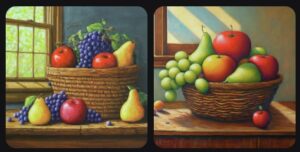Plan Your Masterpiece: How Planning Saves Time and Effort While Painting
Have you ever stared at a blank canvas, brimming with ideas but unsure where to begin? Or maybe you’ve dived right in, only to find yourself frustrated and lost halfway through? Here’s the secret weapon many artists use: planning.
Taking the time to plan your painting before you even touch the paintbrush can save you a ton of time and effort in the long run. It helps you visualize your final piece, avoid mistakes, and ensure a cohesive composition. Let’s explore how to plan your painting efficiently, using a beautiful still life as an example.
1. Find Your Inspiration
What sparks your creativity? Is it a bowl of vibrant fruits, a majestic landscape, or a playful pet? Choosing a subject you’re passionate about fuels your motivation and makes the painting process more enjoyable.
Example: Imagine a rustic wooden table adorned with a basket overflowing with colorful apples, pears, and grapes. Sunlight streams through a window, casting dappled shadows across the scene.

2. Composition is Key
Think about how you want to arrange the elements on your canvas. Consider using the rule of thirds, which divides the canvas into nine equal sections. Place your focal point (perhaps the brightest apple) at one of the intersecting points for a visually balanced composition.
Example: Sketch the table, basket, and fruit loosely on your canvas, keeping the rule of thirds in mind. Play with the arrangement until you achieve a composition that feels pleasing and dynamic.
3. Consider Your Colors
Will you use a realistic color palette or something more expressive? Think about the mood you want to create. Warm colors evoke a sense of joy, while cool colors can feel calming.
Example: Decide if you want to paint the scene realistically or incorporate a touch of whimsy. If realistic, research the colors of the different fruits and table. If whimsical, consider using colors that don’t quite match reality, like a bright blue apple.

4. Brush Up on Your Techniques
Planning isn’t just about aesthetics; it’s about practicality too. Knowing what techniques you’ll use for different elements (shading the apples, creating the wood grain texture) helps you approach the painting strategically.
Example: Research how to achieve realistic shadows and textures with your chosen medium (acrylics, oils, etc.). Practice these techniques on a scrap canvas before transferring them to your main piece.
By following these simple steps, you’ll have a clear roadmap for your painting. This plan will empower you to make confident choices throughout the process, saving time and frustration, and allowing you to focus on the most enjoyable part: creating art!
Remember, planning is a flexible process. Don’t be afraid to adapt your plan as you go – after all, happy accidents can lead to beautiful results!


